A sagging jobs market, high house prices, rising rents and tighter mortgage rules left many youngsters less able to afford a first property.
Owning is too expensive, so there is an increase in demand for renting, and rents have increased from 30% (for boomers) of income to 40% for todays homeowners.
And zoning controls prevent new supply from reaching the market
Rent controls first became popular in the aftermath of two world wars—a time when tenants were a large voting block. Milton Friedman attacked controls in an essay in 1946, warning that they would result in the “haphazard and arbitrary allocation of space, inefficient use of space, [and] retardation of new construction”. Liberal economists regard controls as a zombie policy.
No city today better demonstrates the distortions Friedman warned of than Stockholm. On paper Sweden’s system of rent controls, the hyresreglering is the strictest in the world. A powerful tenants’ union negotiates with landlords, holding rents as much as 50% below the market. In practice lots of people lose out. Swedes must join waiting lists for a rent-controlled apartment: in central Stockholm the average wait is 20 years; across the city it is about half that. Many who reach the front of the queue are in their 50s and own a home. Young Swedes often have to put up with expensive sublets agreed to under the table, laments Mr Persson.






